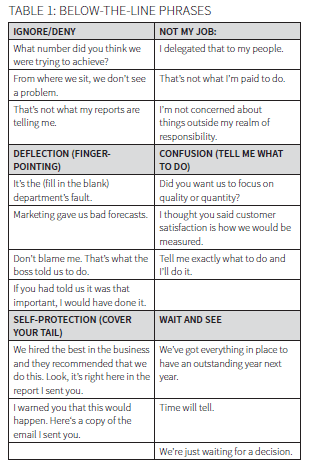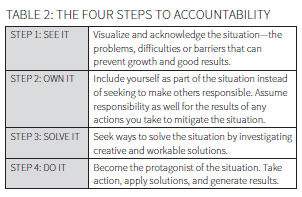In the book Alice’s Adventures in Wonderland, Alice, upon arriving at a crossroads, asks the Cheshire Cat for assistance in choosing which path to take.
The Cat replies, “It depends on where it is you want to go.” Alice answers, “I don’t know really,” whereupon he says, “Then it doesn’t really matter which path you take.”
When it comes to business, however, knowing the path you wish to take can and does matter. If you don’t know where you want to go, any path can seem fine. Unfortunately, many of us have also learned that following just any path easily leads to chaos and a culture in sore need of repair.
One of the most effective ways for a business, company or even a person to obtain stronger and better results is to choose to be accountable.
 What does accountable mean? Essentially, to develop objectives, commit to them, and accept responsibility for their consequences. The Merriam-Webster dictionary defines accountability as: “the quality or state of being accountable; an obligation or willingness to accept responsibility or to account for one’s actions.” Meanwhile, Roger Connors, Tom Smith and Craig Hickman, authors of The Oz Principle—a 1994 business book which has gained a worldwide reputation as “the bible of accountability”—see accountability as a personal choice by individuals to rise above their circumstances, take ownership, and achieve their goals.
What does accountable mean? Essentially, to develop objectives, commit to them, and accept responsibility for their consequences. The Merriam-Webster dictionary defines accountability as: “the quality or state of being accountable; an obligation or willingness to accept responsibility or to account for one’s actions.” Meanwhile, Roger Connors, Tom Smith and Craig Hickman, authors of The Oz Principle—a 1994 business book which has gained a worldwide reputation as “the bible of accountability”—see accountability as a personal choice by individuals to rise above their circumstances, take ownership, and achieve their goals.
This concept, if implemented well, can transform spectators into protagonists, responsible for their attitudes, their actions, and the consequences of their actions.
How can such a concept be implemented by a person or company to maximize results? First, according to The Oz Principle, by identifying the very behaviors that reflect accountability as well as those that do not, and measuring them. Such behaviors can be classified as either “above-the-line” or “below-the-line.” Below-the-line thoughts, attitudes and behaviors are generally negative, and the very antithesis of accountability. They sort into six basic categories: ignore/deny, “not my job,” deflection (finger-pointing), confusion (tell me what to do), self-protection (cover your tail), and wait and see.
The table below, derived from a study by accountability training firm Partners in Leadership, cites many of the most typical and common below-the-line phrases in each of the six categories that are heard most by managers:
We have all heard at least some of these phrases. Indeed, some of us may even have used them! These are great examples of behaviors that must not be adopted if a culture of accountability is desired.
“Above-the-line” thoughts, attitudes and behaviors, on the other hand, communicate positive attitudes when facing challenging situations. These are the ones that engender accountability.
If you wish to shape your personal and workplace environments, speed and augment growth within yourself and your company and maximize achievements for both, look to the Four Steps to Accountability, as described in The Oz Principle, which I paraphrase below.

In essence, becoming an accountability professional requires a journey from claim to action. What does this mean? Fundamentally, it means taking responsibility. With any situation we claim in our lives, be it personal or professional, each of us must choose to take the steps and actions that will result in its resolution.
Unfortunately, many individuals stop taking such actions exactly when a situation becomes too uncomfortable or difficult to handle. Instead of facing the difficulty, dealing with the discomfort it elicits and trying to come up with solutions, many prefer to turn away—to, in essence, bury their heads in the sand.
Becoming accountable, however, requires the exact opposite. One fundamental step toward accountability is taking the risk of “touching the wounds”—that is, approaching and actually handling that which might seem too difficult or even painful to confront. My mother used to quote the popular saying, “what cures, burns.” To achieve accountability, whether personally or in our careers, we must risk touching the wounds that are hurting our success and harming our ability to maximize results.
The first small action, even before the Four Steps, however, is determining where to start or which actions to take. This is frequently where people get stuck. Defining the intended goals, objectives, or results, whether personal or corporate, is the best way to achieve total clarity and avoid the dreaded “any path will suffice” thinking.
Once the problems are identified and goals are set, you can then use the four steps outlined in Table 2 to respond to whatever challenges might arise. All of them can be faced in this manner—seeing and owning the problems, searching ways to solve them,
implementing the solutions, and owning the results.
The same steps can also be applied to challenges within a business or corporate environment—goals and objectives must be clearly set and then fine-tuned so that they can be fully reached. This will be the subject of the next article, which will cover the main elements a company can use to apply and achieve an accountability culture.
To sum up: each of us must know where we want to go. This must be the starting point for the Four Steps. To paraphrase Danton Velloso, chief executive officer of the business training company DOOR International Brasil Consultoria Empresarial Ltda.: “Between wanting and can, there is a distance. The path that unites this distance is accountability.”



 What does accountable mean? Essentially, to develop objectives, commit to them, and accept responsibility for their consequences. The Merriam-Webster dictionary defines accountability as: “the quality or state of being accountable; an obligation or willingness to accept responsibility or to account for one’s actions.” Meanwhile, Roger Connors, Tom Smith and Craig Hickman, authors of The Oz Principle—a 1994 business book which has gained a worldwide reputation as “the bible of accountability”—see accountability as a personal choice by individuals to rise above their circumstances, take ownership, and achieve their goals.
What does accountable mean? Essentially, to develop objectives, commit to them, and accept responsibility for their consequences. The Merriam-Webster dictionary defines accountability as: “the quality or state of being accountable; an obligation or willingness to accept responsibility or to account for one’s actions.” Meanwhile, Roger Connors, Tom Smith and Craig Hickman, authors of The Oz Principle—a 1994 business book which has gained a worldwide reputation as “the bible of accountability”—see accountability as a personal choice by individuals to rise above their circumstances, take ownership, and achieve their goals.